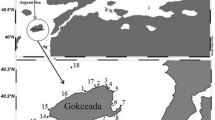Abstract
The generic composition of the heterotrophic bacterial population of Tokyo Bay, which is now highly polluted and eutrophic, was compared with that of the adjacent, less polluted regions of Sagami Bay and Suruga Bay. Members of Vibrionaceae predominated in the bacterial flora of seawater and zooplankton samples from Sagami Bay, Suruga Bay, and the mouth of Tokyo Bay. However,Vibrio spp. formed only a small proportion of the bacterial population of the water and sediment samples from the inner Tokyo Bay; there the Gram-negative, nonmotile, nonpigmented bacteria, which were tentatively identified asAcinetobacter, were predominant. The result of experiments, in which seawater samples from Tokyo Bay were incubated under various experimental conditions, indicated that two significant factors apparently control the growth ofVibrio spp. in seawater; (1) a direct antagonism betweenVibrios and phytoplankton undergoing rapid growth, and (2) a limiting organic nutrient forvibrios.
Similar content being viewed by others
References
APHA. AWWA. WPCF. 1965. Standard methods for the examination of water and waste water. Pp. 769. 12th Ed. Amer. Publ. Health Assoc. Inc., New York.
Funakoshi, M. 1973. Pollution of inner bays and occurrence of red tide (in Japanese).Memoir. Rikkyo Jogakuin 2: 35–52.
Gunkel, W., and Oppenheimer, C. H. 1963. Experiments regarding the sulfide formation in sediments of the Texas Gulf Coast. pp. 674–684,In: Marine Microbiology. C. H. Oppenheimer, editor.
Jannasch, H. W. 1958. Studies on planktonic bacteria by means of a direct membrane filter method.J. Gen. Microbiol. 18: 609–620.
Kaneko. T., and Colwell, R. R. 1975. Incidence ofVibrio parahaemolyticus in Chesapeake Bay.Appl. Microbiol. 30: 251–257.
Kaneko, T., and Colwell, R. R. 1975. Adsorption ofVibrio parahaemolyticus onto chitin and copepoda.Appl. Microbiol. 29: 269–274.
Kuznetsov, S. I. 1970. Microflora of lakes and Its Geochemical Activity. pp. 440. Publishing Office Nauka, Leningrad.
Leistner, L., and Hechelmann, H. 1974. Occurrence and significance ofVibrio parahaemolyticus in Europe. pp. 83–90.In: International Symposium onVibrio parahaemolyticus. T. Fujino, G. Sakaguchi, R. Sakazaki and Y. Takeda, editors. Saikon Publ. Co., Ltd., Tokyo.
Maeda, M. 1975. Ecological studies on nucleic acids-hydrolyzing bacteria in marine environments. pp. 163. Ph.D. thesis. Tokyo Univ.
Marumo, R., and Murano, M. 1973. Succession of plankton diatoms in Tokyo Bay (in Japanese with English abstract). La mer (Bull. Soc. franco-japonaise d'óceanograph.)11: 70–82.
Shewan, J. M., Hobbs, G., and Hodgkiss, W. 1960. ThePseudomonas andAchromobacter groups of bacteria in the spoilage of marine white fish.J. Appl. Bacteriol. 23: 463–468.
Sieburth, J. M. 1968. Observations on bacteria planktonic in Narragansett Bay, Rhode Island: A resumé.Bull. Misaki Marine Biol. Inst. Kyoto Univ. 12: 49–64.
Simidu, U., and Aiso, K. 1962. Occurrence and distribution of heterotrophic bacteria in sea water from the Kamogawa Bay.Bull. Japan. Soc. Sci. Fisheries 28: 1133–1141.
Simidu, U., Ashino, K., and Kaneko, E. 1971. Bacterial flora of phytoand zoo-plankton in the inshore water of Japan.Can. J. Microbiol. 17: 1157–1160.
Simidu, U. 1974. Taxonomy of marine bacteria. pp. 45–65.In: Marine Microorganisms (in Japanese). N. Taga, editor. University of Tokyo Press, Tokyo.
Taga, N. 1968. Some ecological aspects of marine bacteria in the Kuroshio current.Bull. Misaki Marine Biol. Inst. Kyoto Univ. 12: 65–76.
Winogradsky, S. N. 1952. Soil Microbiology. pp. 792. Publishing Office of USSR Academy of Science, Moscow.
Author information
Authors and Affiliations
Rights and permissions
About this article
Cite this article
Simidu, U., Kaneko, E. & Taga, N. Microbiological studies of Tokyo Bay. Microb Ecol 3, 173–191 (1977). https://doi.org/10.1007/BF02010616
Issue Date:
DOI: https://doi.org/10.1007/BF02010616



